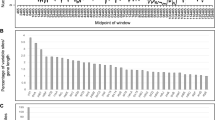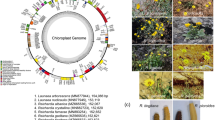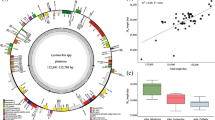Abstract
This project examines the relationships within the genus Zea using complete plastid genomes (plastomes). While Zea mays has been well studied, congeneric species have yet to be as thoroughly examined. For this study four complete plastomes and a fifth nearly complete plastome were sequenced in the five species (Zea diploperennis, Zea perennis, Zea luxurians, Zea nicaraguensis, and Zea mays subsp. huehuetenangensis) by Sanger or next-generation methods. An analysis of the microstructural changes, such as inversions, insertion or deletion mutations (indels) and determination of their frequencies were performed for the complete plastomes. It was determined that 193 indels and 15 inversions occurred across the examined plastomes of Zea. Tandem repeat indels were the most common type of microstructural change observed. Divergence times were estimated using a noncorrelated relaxed clock method. Divergence dates for specific nodes relative to Zea were calculated to fall between 38,000 years before present (YBP) for the subspecies included in this study and 23,000 YBP for section Luxuriantes included in this study. The stem lineage of all Zea species was calculated to have diverged at 176,000 YBP. The calculated mutation rates for the genus fell within the range of 1.7E−8 to 3.5E−8 microstructural changes per site per year. These rates of change are not uniform, despite the close relationships of taxa in this study. Phylogenomic analyses using full plastome alignments were also conducted to compare tree topologies from different types of mutations. In most cases, the previous work examining Zea mitochondrial and nuclear data was confirmed.




Similar content being viewed by others
References
Akaike H (1974) A new look at the statistical model identification. Inst Electr Electron Eng Trans Autom Control 19:716–723
Bouckaert R et al (2014) BEAST 2: a software platform for Bayesian evolutionary analysis PLoS Comput Biol 10.4:e1003537
Burke SV, Grennan CP, Duvall MR (2012) Plastome sequences of two New World bamboos—Arundinaria gigantea and Cryptochloa strictiflora (Poaceae)—extend phylogenomic understanding of Bambusoideae. Am J Bot 99(12):1951–1961
Caruccio N (2011) Preparation of next-generation sequencing libraries using Nextera™ technology: simultaneous DNA fragmentation and adaptor tagging by in vitro transposition. High-throughput next generation sequencing. Humana Press, New York, pp 241–255
Christin PA et al (2008) Evolutionary switch and genetic convergence on rbcL following the evolution of C4 photosynthesis. Mol Biol Evolut 25(11):2361–2368
Christin PA et al (2013) Molecular dating, evolutionary rates, and the age of the grasses. Syst Biol 63(2):153–165
Clegg MT (1993) Chloroplast gene sequences and the study of plant evolution. Proc Natl Acad Sci 90(2):363–367
Cox M et al (2010) SolexaQA: at-a-glance quality assessment of Illumina second-generation sequencing data. BMC Bioinform 11:485
Darracq Aude, Varré Jean-Stéphane, Touzet Pascal (2010) A scenario of mitochondrial genome evolution in maize based on rearrangement events. BMC Genom 11(1):233
Darriba D, Taboada GL, Doallo R, Posada D (2012) jModelTest 2: more models, new heuristics and parallel computing. Nat Methods 9(8):772
Dhingra A, Folta K (2005) ASAP: amplification, sequencing and annotation of plastomes. BMC Genom 6:176
Doebley J (2003) Laboratory of Genetics. University of Wisconsin-Madison. (2003) http://teosinte.wisc.edu/taxonomy.html
Doebley J et al (1987) Insertion/deletion mutations in the Zea chloroplast genome. Curr Genet 11:617–624
Duvall MR et al (2016) Phylogenomics and plastome evolution of the chloridoid grasses (Chloridoideae: Poaceae). Int J Plant Sci 177(3):235–246
Felsenstein J (2005) PHYLIP (phylogeny inference package). Distributed by the author. Department of Genome Sciences, University of Washington, Seattle
Fuglie K et al (2012) Private Industry Investing Heavily, and Globally, in Research To Improve Agricultural Productivity. Amber Waves 2
Gaut BS, Clegg MT (1993) Molecular evolution of the Adh1 locus in the genus Zea. Proc Natl Acad Sci 90(11):5095–5099
George B, Bhavin BS, Awasthi M, George B, Singh AK (2015) Comparative analysis of microsatellites in chloroplast genomes of lower and higher plants. Curr Genet 61:665–677. doi:10.1007/s00294-015-0495-9
Graham Sean W, Reeves Patrick A, Burns ACE, Olmstead RG (2000) Microstructural changes in noncoding chloroplast DNA: interpretation, evolution, and utility of indels and inversions in basal angiosperm phylogenetic inference. Int J Plant Sci 161:S83–S96
Graur D, W. Li. “H (2000) Fundamentals of molecular evolution. Sinauer, Sunderland, Ma
Hajek T (2015) Characterization of microstructural mutation events in plastomes of chloriodoid grasses (Chloridoideae; Poaceae). Northern Illinois University. Department of Biological Sciences. MS Thesis
Hedberg O (1969) Evolution and speciation in a tropical high mountain flora. Biol J Linn Soc 1(1-2):135–148
Hilton H, Gaut BS (1998) Speciation and domestication in maize and its wild relatives: evidence from the globulin-1 gene. Genetics 150(2):863–872
Hodkinson TR et al (2002) Phylogenetics of Miscanthus, Saccharum and related genera (Saccharinae, Andropogoneae, Poaceae) based on DNA sequences from ITS nuclear ribosomal DNA and plastid trnL intron and trnL-F intergenic spacers. J Plant Res 115(5):381–392
Hufford MB et al (2012) Teosinte as a model system for population and ecological genomics. Trends Genet 28(12):606–615
Iles WJD et al (2015) Monocot fossils suitable for molecular dating analyses. Botanical Journal of the Linnean Society
Jones SS, Burke SV, Duvall MR (2014) Phylogenomics, molecular evolution, and estimated ages of lineages from the deep phylogeny of Poaceae. Plant Syst Evol 300(6):1421–1436
Katoh K, Standley DM (2013) MAFFT multiple sequence alignment software version 7: improvements in performance and usability. Mol Biol Evolut 30(4):772–780
Kearse M et al (2012) Geneious basic: an integrated and extendable desktop software platform for the organization and analysis of sequence data. Bioinformatics 28(12):1647–1649
Kelchner SA (2000) The evolution of non-coding chloroplast DNA and its application in plant systematics. Annals of the Missouri Botanical Garden 482–498
Kelchner SA, Wendel JF (1996) Hairpins create minute inversions in non-coding regions of chloroplast DNA. Curr Genet 30(3):259–262
Keppel G et al (2012) Refugia: identifying and understanding safe havens for biodiversity under climate change. Global Ecol Biogeogr 21(4):393–404
Kim KJ, Lee HL (2005) Widespread occurrence of small inversions in the chloroplast genomes of land plants. Mol Cells 19(1):104–113
Larkin MA et al (2007) Clustal W and Clustal X version 2.0. Bioinformatics 23(21):2947–2948
Leseberg CH, Duvall MR (2009) The complete chloroplast genome of Coix lacryma-jobi and a comparative molecular evolutionary analysis of plastomes in cereals. J Mol Evol 69(4):311–318
Levinson G, Gutman GA (1987) Slipped-strand mispairing: a major mechanism for DNA sequence evolution. Mol Biol Evolut 4(3):203–221
Ma J, Li XQ (2015) Organellar genome copy number variation and integrity during moderate maturation of roots and leaves of maize seedlings. Curr Genet 61:591–600. doi:10.1007/s00294-015-0482-1
Maier RM et al (1995) Complete sequence of the maize chloroplast genome: gene content, hotspots of divergence and fine tuning of genetic information by transcript editing. J Mol Biol 251(5):614–628
Matsuoka Y et al (2002) A single domestication for maize shown by multilocus microsatellite genotyping. Proc Natl Acad Sci 99(9):6080–6084
Mercader J (2009) Mozambican grass seed consumption during the Middle Stone Age. Science 326(5960):1680–1683
Miller MA, Pfeiffer W, Schwartz T (2010) Creating the CIPRES science gateway for inference of large phylogenetic trees. In Proceedings of the Gateway Computing Environments Workshop (GCE), 14 Nov. 2010, New Orleans, LA pp 1–8
Mudelsee M, Michael S (1997) The Mid-Pleistocene climate transition: onset of 100 ka cycle lags ice volume build-up by 280 ka. Earth and Planetary Science Letters 151(1):117–123
Murray SC, Jessup RW (2014) Breeding and Genetics of Perenial Maize: Progress, Opportunities and Challenges. http://www.landinstitute.org/wp-content/uploads/2014/11/PF_FAO14_ch08.pdf
Oldenburg DJ, Bendich AJ (2016) The linear plastid chromosomes of maize: terminal sequences, structures, and implications for DNA replication. Curr Genet 62:431–442. doi:10.1007/s00294-015-0548-0
Posada D (2003) jModelTest: phylogenetic model averaging. Molecular biology and evolution. Guindon S and Gascuel O (2003). A simple, fast and accurate method to estimate large phylogenies by maximum-likelihood. Systematic Biology 52:696–704
Rambaut A et al. (2014) FigTree v1.4.2, Available from http://tree.bio.ed.ac.uk/software/figtree/
Rambaut A, Drummond J (2009) Tracer v1.5. Website http://tree.bio.ed.ac.uk/software/tracer/
Ranum P, Peña-Rosas JP, Garcia-Casal MN (2014) Global maize production, utilization, and consumption. Ann N Y Acad Sci 1312(1):105–112
Rokas A, Holland PWH (2000) Rare genomic changes as a tool for phylogenetics. Trends Ecol Evol 15(11):454–459
Ronquist F, Huelsenbeck JP (2003) MRBAYES 3: Bayesian phylogenetic inference under mixed models. Bioinformatics 19:1572–1574
Ronquist F, Teslenko M, van der Mark P, Ayres DL, Darling A, Höhna S, Huelsenbeck JP (2012) MrBayes 3.2: efficient Bayesian phylogenetic inference and model choice across a large model space. Syst Biol 61(3):539–542
Ross-Ibarra J, Tenaillon M, Gaut BS (2009) Historical divergence and gene flow in the genus Zea. Genetics 181(4):1399–1413
Saarela JM, William PW, Craig FB, Robert J. Soreng, Jerrold I. Davis, Lynn G. Clark, Scot A. Kelchner, J. Chris Pires, Patrick P. Edger, Dustin R. Mayfield, Duvall MR (2015) Plastid phylogenomics of the cool-season grass subfamily: clarification of relationships among early-diverging tribes. AoB plants, plv046
Sánchez JJ, Ruiz CJA (1995) Distribución del teocintle en México. Memorias del Foro “Flujo genético entre maíz criollo, maíz mejorado y teocintle: implicaciones para el maíz transgénico”. Centro Internacional de Mejoramiento de Maíz y Trigo, México, DF, México, pp 20–38
Schnable PS et al (2009) The B73 maize genome: complexity, diversity, and dynamics. Science 326(5956):1112–1115
Schonbeck M. Virginia Association for Biological Farming. “Design the cropping system to minimize niches for weed growth.” Extension. (30 August 2011). http://www.extension.org/pages/18697/design-the-cropping-system-to-minimize-niches-for-weed-growth#.VfLg9hHBzRZ. Accessed 2015
Shimodaira H, Hasegawa M (1999) Multiple comparisons of log-likelihoods with applications to phylogenetic inference. Mol Biol Evol 16:1114–1116
Stamatakis A (2014) RAxML Version 8: a tool for phylogenetic analysis and post-analysis of large phylogenies. Bioinformatics. doi:10.1093/bioinformatics/btu033. http://bioinformatics.oxfordjournals.org/content/early/2014/01/21/bioinformatics.btu033.abstract
Swofford DL (2003) PAUP*. Phylogenetic Analysis Using Parsimony (*and Other Methods). Version 4. Sinauer Associates, Sunderland, Massachusetts
Toledo VM (1982) Pleistocene changes of vegetation in tropical Mexico. Biological diversification in the tropics: proceedings, fifth international symposium of the Association for Tropical Biology, held at Macuto Beach, Caracas, Venezuela, February 8–13, 1979/edited by GT Prance. New York: Columbia University Press
USDA. Economic Research Service. World Agricultural Supply and Demand Estimates. May 10, 2016. http://www.usda.gov/oce/commodity/wasde/latest.pdf
USDA. Foreign Agricultural Service. http://apps.fas.usda.gov/psdonline/psdreport.aspx?hidReportRetrievalName=BVS&hidReportRetrievalID=884&hidReportRetrievalTemplateID=1. Accessed: 2014
Vicentini A et al (2008) The age of the grasses and clusters of origins of C4 photosynthesis. Global Change Biol 14(12):2963–2977
Wu DY et al (1991) The effect of temperature and oligonucleotide primer length on the specificity and efficiency of amplification by the polymerase chain reaction. DNA Cell Biol 10(3):233–238
Wysocki WP, Clark LG, Kelchner SA, Burke SV, Pires JC, Edger PP, Mayfield DR, Triplett JK, Columbus JT, Ingram AL, Duvall MR (2014) A multi-step comparison of short-read full plastome sequence assembly methods in grasses. Taxon
Yamane K, Yano K, Kawahara T (2006) Pattern and rate of indel evolution inferred from whole chloroplast intergenic regions in sugarcane, maize and rice. DNA Res 13(5):197–204
Zerbino D, Birney E (2008) Velvet algorithims for de novo short read assembly using de Bruijn graphs. Genome Res 18:821–829
Acknowledgments
We thank the Iowa State University Seed Science Center and Seed Lab under the direction of Mr. Mike Stahr, the Small Seed Department Head, Ms. Kim North, and Mr. Mark Millard of the USDA/ARS Plant Introduction Station at Iowa State University for providing the seed accessions used within this study. We also extend our gratitude to Dr. Scot Kelchner for providing a review of an earlier draft of this manuscript. We acknowledge the support of the National Science Foundation (NSF Grants DEB-1120761 and DEB-1342782 to MRD). Any opinions, findings, and conclusions or recommendations expressed in this material are those of the authors and do not necessarily reflect the views of the National Science Foundation. Finally, we thank the Department of Biological Sciences and the Plant Molecular and Bioinformatics Center at Northern Illinois University for financial assistance.
Author information
Authors and Affiliations
Corresponding author
Additional information
Communicated by M. Kupiec.
Sean V. Burke, William P. Wysocki, and Melvin R. Duvall contributed equally to this work.
Nucleotide sequence data reported are available in the GenBank database under the accession numbers: KR873421, KR873422, KR873423, KR873424, and KU291447.
Electronic supplementary material
Below is the link to the electronic supplementary material.
Rights and permissions
About this article
Cite this article
Orton, L.M., Burke, S.V., Wysocki, W.P. et al. Plastid phylogenomic study of species within the genus Zea: rates and patterns of three classes of microstructural changes. Curr Genet 63, 311–323 (2017). https://doi.org/10.1007/s00294-016-0637-8
Received:
Revised:
Accepted:
Published:
Issue Date:
DOI: https://doi.org/10.1007/s00294-016-0637-8




